The current bridge has its own post.
The Metropolitan Bridge that is behind this one in many of the photos has this post.
According to Chicagology, there was also a tunnel between 1892 and 1952. Chicagology also lists six bridges that were at this site.
 |
| Todd Protzman Davis shared Patrick McBriarty  Those two bridges where the first Scherzer rolling-lift bridges in the world ever built. Their inventor William Scherzer received the patent post-humously and his brother Albert started the company. Both were Chicagoans. Those two bridges where the first Scherzer rolling-lift bridges in the world ever built. Their inventor William Scherzer received the patent post-humously and his brother Albert started the company. Both were Chicagoans.Zachary Tailor Davis posted [Note the Union Station buildings in the background.] |
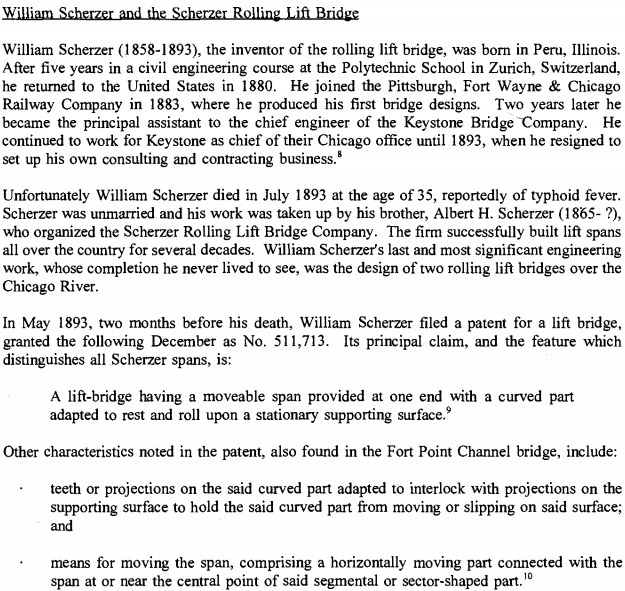 |
| HAER, p7 (source) |
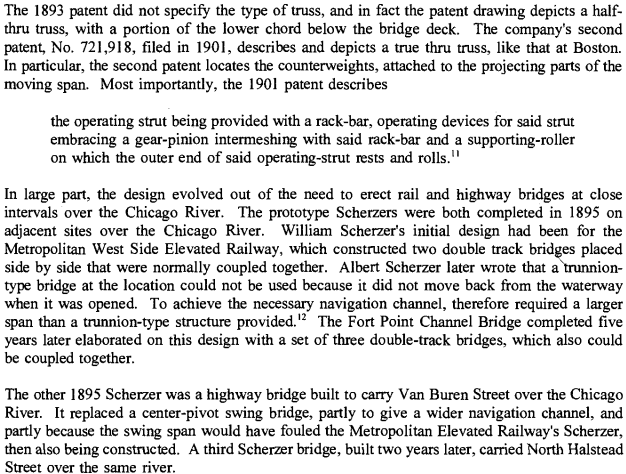 |
| HAER, p8 (source) In the following decades, a large number of rolling lift bridges were built, both for rail and highway traffic. In a 1902 letter to the Railroad Gazette, Albert Scherzer wrote that more Scherzer rolling lift bridges had been built than all other types of bascules combined. [1902 is when MWRD had built a lot of rolling bridges along the Chicago River and before Chicago replaced them with trunnion briges.] |
This view shows both of the first two bridges designed by William Scherzer and built by Albert Scherzer.
 |
| Darla Zailskas posted Van Buren Street Bridge 1949, the Scherzer rolling-lift bridge shown here at Van Buren, looking northeast, was replaced by a bascule bridge opened in Dec. 1956. The bridge in the background was the famous Metropolitan West Side Elevated Railway bridge used for rapid transit from 1895 until June 22, 1958, when service began on the Congress Expressway. Always used for electric trains, this bridge was the only 4 track bridge in Chicago's history and also served the Chicago Aurora & Elgin Railway AS TOLD by the Department of Public Works |
 |
| Published prior to 1923, from Bridge Hunter, 1895 [This shows the west leaf in the raised position and all of the leaves of the Metropolitan "L" Bridge.] |
 |
| May 11, 1895 Scientific American via Chicagology, Digitized by Google |
 |
| May 11, 1895 Scientific American, Digitized by Google |
 |
| May 11, 1895 Scientific American [Why is there a steam locomotive on Van Buren Street? The elevated trains used steam until electric propulsion was developed. But I thought streetcars used horses before they used electricity.] |
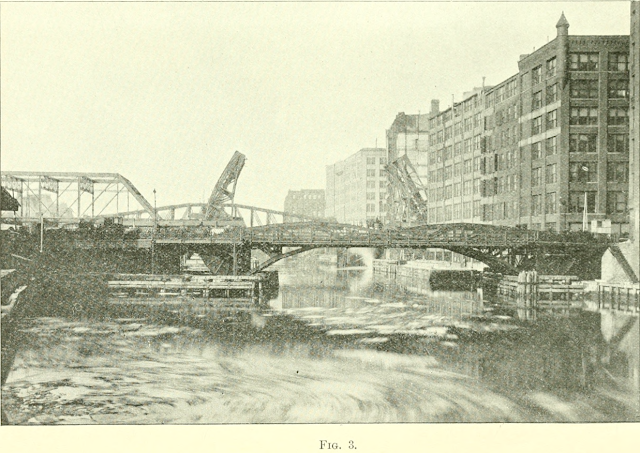 |
| Association of Engineering Societies, Vol XV, July to December, 1895 |
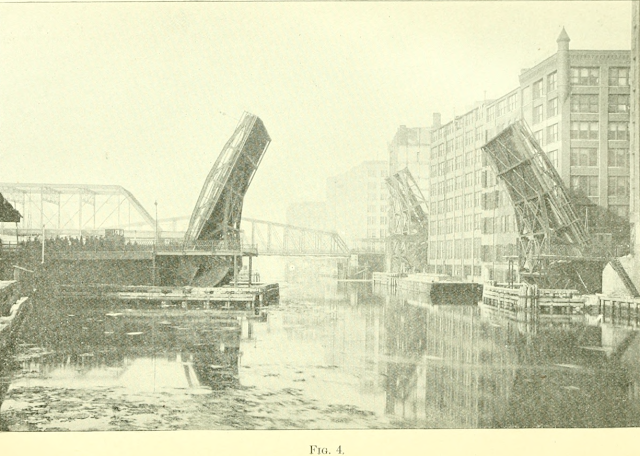 |
| Association of Engineering Societies, Vol XV, July to December, 1895 |
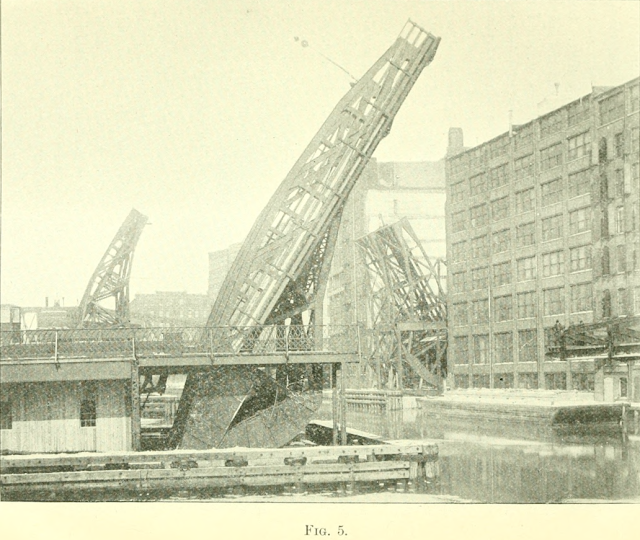 |
| Association of Engineering Societies, Vol XV, July to December, 1895 |
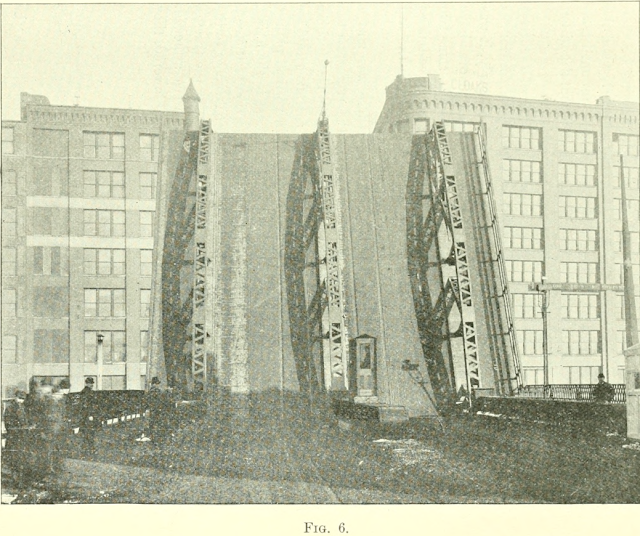 |
| Association of Engineering Societies, Vol XV, July to December, 1895
Fig. 6 gives a view looking east upon the west half of the bridge when open. We have here very forcibly presented the amount of wind-surface offered when the bridge is fully opened. The area above the line of the roadway amounts to about 3,300 square feet, and a pressure of 18 pounds per square foot gives a pull in the operating strut of 165,000 pounds.
This is the maximum stress for which the operating strut and the machinery were figured; it being assumed that traffic on the river would stop with a wind which would give 18 lb/sq ft. Mr. Trautwine, in his "pocket-Book," gives 18 lb/sq. ft. as corresponding to a violent storm of 60 miles per hour.
[Each side was operated independently from a control cab mounted on the center approach girder.] |
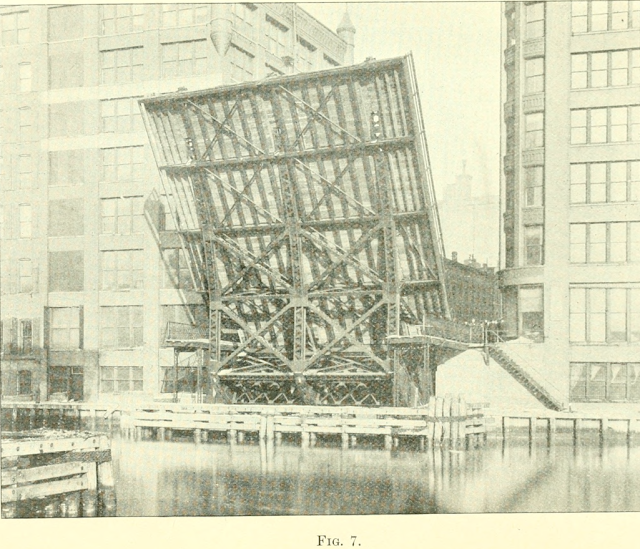 |
| Association of Engineering Societies, Vol XV, July to December, 1895 |
The third bridge at this site was the first swing bridge, and it was built in 1867 with wood and iron. Below is what was left after the Great Fire of 1871.
 |
| Chicagology |
The swing bridge in the background should be the Van Buren Street Bridge. 1902 would be before the river was straightened.
 |
| MWRD posted The east abutment for a temporary bridge being built at Harrison Street in Chicago on November 7, 1902, viewed to the north from the east side of the South Branch of the Chicago River. |
 |
| MWRD posted on Jan 5, 2023 A view from the Jackson Street bridge looking south towards Van Buren on September 5, 1903, showing an area adjacent to and above the bypass channel on the South Branch of the Chicago River. |
 |
| Steve Lewandowski posted 1909 rebuild |
No comments:
Post a Comment